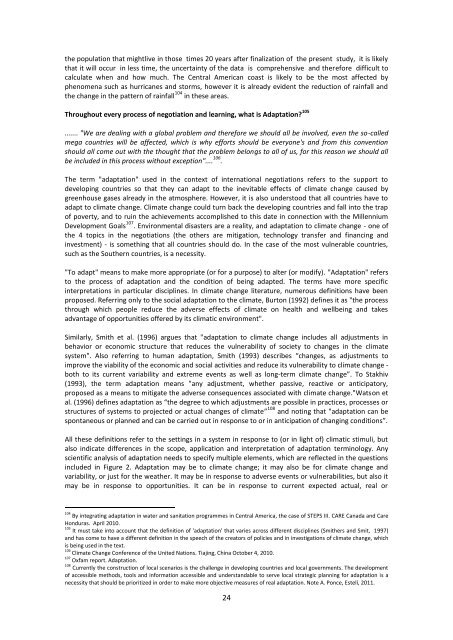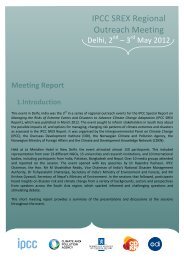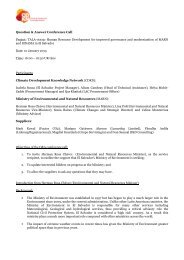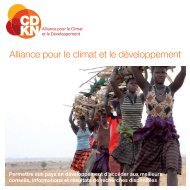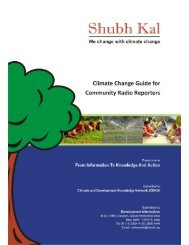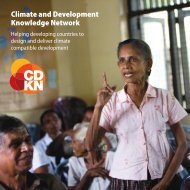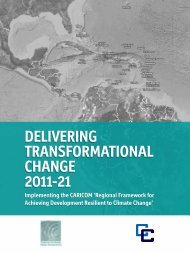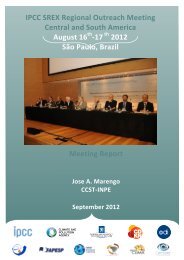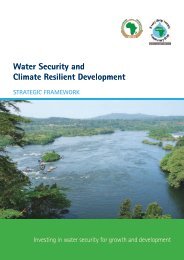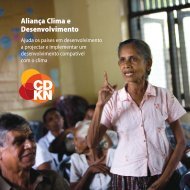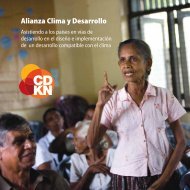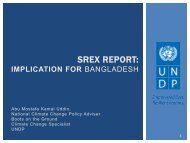the population that mightlive in those times 20 years after finalization of the present study, it is likelythat it will occur in less time, the uncertainty of the data is comprehensive and therefore difficult tocalculate when and how much. The Central American coast is likely to be the most affected byphenomena such as hurricanes and storms, however it is already evident the reduction of rainfall andthe change in the pattern of rainfall 104 in these areas.Throughout every process of negotiation and learning, what is Adaptation? 105....... "We are dealing with a global problem and therefore we should all be involved, even the so-calledmega countries will be affected, which is why efforts should be everyone's and from this conventionshould all come out with the thought that the problem belongs to all of us, for this reason we should allbe included in this process without exception".... 106 .The term "adaptation" used in the context of international negotiations refers to the support todeveloping countries so that they can adapt to the inevitable effects of climate change caused bygreenhouse gases already in the atmosphere. However, it is also understood that all countries have toadapt to climate change. Climate change could turn back the developing countries and fall into the trapof poverty, and to ruin the achievements accomplished to this date in connection with the MillenniumDevelopment Goals 107 . Environmental disasters are a reality, and adaptation to climate change - one ofthe 4 topics in the negotiations (the others are mitigation, technology transfer and financing andinvestment) - is something that all countries should do. In the case of the most vulnerable countries,such as the Southern countries, is a necessity."To adapt" means to make more appropriate (or for a purpose) to alter (or modify). "Adaptation" refersto the process of adaptation and the condition of being adapted. The terms have more specificinterpretations in particular disciplines. In climate change literature, numerous definitions have beenproposed. Referring only to the social adaptation to the climate, Burton (1992) defines it as "the processthrough which people reduce the adverse effects of climate on health and wellbeing and takesadvantage of opportunities offered by its climatic environment".Similarly, Smith et al. (1996) argues that "adaptation to climate change includes all adjustments inbehavior or economic structure that reduces the vulnerability of society to changes in the climatesystem". Also referring to human adaptation, Smith (1993) describes “changes, as adjustments toimprove the viability of the economic and social activities and reduce its vulnerability to climate change -both to its current variability and extreme events as well as long-term climate change”. To Stakhiv(1993), the term adaptation means "any adjustment, whether passive, reactive or anticipatory,proposed as a means to mitigate the adverse consequences associated with climate change."Watson etal. (1996) defines adaptation as “the degree to which adjustments are possible in practices, processes orstructures of systems to projected or actual changes of climate” 108 and noting that "adaptation can bespontaneous or planned and can be carried out in response to or in anticipation of changing conditions”.All these definitions refer to the settings in a system in response to (or in light of) climatic stimuli, butalso indicate differences in the scope, application and interpretation of adaptation terminology. Anyscientific analysis of adaptation needs to specify multiple elements, which are reflected in the questionsincluded in Figure 2. Adaptation may be to climate change; it may also be for climate change andvariability, or just for the weather. It may be in response to adverse events or vulnerabilities, but also itmay be in response to opportunities. It can be in response to current expected actual, real or104 By integrating adaptation in water and sanitation programmes in Central America, the case of STEPS III. CARE Canada and CareHonduras. April 2010.105 It must take into account that the definition of 'adaptation' that varies across different disciplines (Smithers and Smit, 1997)and has come to have a different definition in the speech of the creators of policies and in investigations of climate change, whichis being used in the text.106 Climate Change Conference of the United Nations. Tiajing, China October 4, 2010.107 Oxfam report. Adaptation.108Currently the construction of local scenarios is the challenge in developing countries and local governments. The developmentof accessible methods, tools and information accessible and understandable to serve local strategic planning for adaptation is anecessity that should be prioritized in order to make more objective measures of real adaptation. Note A. Ponce, Estelí, 2011.24
projected 109 conditions, changes or consequences. Therefore, analysis of adaptation must specify thestimulus for adaptive responses that are studying, ie, "adapt to what?" (Figure 2). The system on whichthe adjustment is made must also specify. “Who or what adapts?” They may be individuals, social andeconomic sectors and activities, managed or natural or ecological systems or practices, processes orstructures of systems. The systems, once specified, can be distinguished by characteristics such as theirability to adaptation or vulnerability. Despite the lack of adaptation indicators it is key factor especiallyin local ecosystems.From: Adaptation to Climate Change and variability (Smith et al., 1999).There are still many questions related to climate change and its impacts on biodiversity, livelihoods andcountries, all these are questions in the debate, at local, national and international levels and it isessential to look for answers. Biodiversity, livelihoods and resources have a variety of vulnerabilities, todefined threats of climate change; there are few research efforts at this moment that allows at least,with a certain acceptable level of certainty of impacts on them. Adaptation has its own specificcharacteristics, needs and requirements, - scientific, economic, and political and so on, that must betaken into account in local adaptation strategies. There are no recipes, while mitigation is taken as aglobal adaptation, efforts should be based on the local. The unification of different managementframeworks has been used to improve institutional 110 management and strategic planning for the fightagainst poverty. Hazards and disasters that have occurred to this day, especially the impacts on humanlives and livelihoods around the world, requires today, even more of this integration, harmonization andunification of approaches in all fields and areas where possible to reduce vulnerability. The actions ofDRR - in its four main components - such as the CCA should include in a concrete way the benefits oftheir procedures clearly and with resources and clear indicators. Annex II presents some of the benefitsand "gates" of entry where you can see the complementarities between the differentapproaches 111 . Existing resources in developing countries are insufficient to make such adjustments andadaptation - is still unknown the exact impact-. To do this, Bali decided to consolidate the AdaptationFund (Adaptation Fund), whose secretariat will be in the <strong>Global</strong> Environmental Facility (GEF) and the109 Currently local capacity to generate non-physical and meteorological scenarios, but biological and socio-economic impacts ofclimate change is a significant barrier that must be bypassed in the local level. Economic capacities for these settings are verylimited and slow march of global agreements. Note A. Ponce. Estelí. 2011.110 For example, a Unified Framework experience is the CARE International Management and its theory of change. Note A. PonceNovember 2010.111 There are tools such as CRiSTAL, CVCA, among others that allow the integration of CCA and DRR programmes and projects.CARE has validated these tools in agriculture and water and sanitation.25
- Page 3 and 4: Executive SummaryCentral America is
- Page 5 and 6: Central is located in the "Ring of
- Page 7 and 8: Study ContentAs an innovative theme
- Page 9 and 10: that coexist in the universe. This
- Page 11 and 12: Central America level, is the only
- Page 13 and 14: of Mesoamerica has been explained a
- Page 15 and 16: possesses effective cultural commun
- Page 17 and 18: Additionally, to succeed and achiev
- Page 19 and 20: eforestation, hydrological planning
- Page 21 and 22: General thematic introduction on Cl
- Page 23: Central American Governments should
- Page 27 and 28: General introduction on the themati
- Page 29 and 30: participatory manner, to address di
- Page 31 and 32: Causes and complementary consequenc
- Page 33 and 34: Organizational and legal contextWhi
- Page 35 and 36: The three bodies within the SICA ar
- Page 37 and 38: Based on research of available info
- Page 39 and 40: SE-CONREDCivilProtectionSNETCCNISCO
- Page 41 and 42: Synergy model that displays the add
- Page 43 and 44: Added value of indigenous and local
- Page 45 and 46: They do not work in a separate mann
- Page 47 and 48: demand for agricultural raw materia
- Page 49 and 50: Amazon DIPECHO Project “Strengthe
- Page 51 and 52: Indigenous Knowledge on DisasterMit
- Page 53 and 54: The combination of indigenous andsc
- Page 55 and 56: Indigenous Skills and the mysticism
- Page 57 and 58: Weather forecast through indigenous
- Page 59 and 60: In various international convention
- Page 61 and 62: Recommended ReadingBennett, A., 200
- Page 63 and 64: ILO, 1993, Convenio sobre pueblos i
- Page 65 and 66: Local knowledgeIncludes people and
- Page 67 and 68: which are threatswith a certainprob
- Page 69 and 70: Appreciates and respects their orga
- Page 71 and 72: framework, without taking into acco
- Page 73 and 74: Currently Cacaopera ethnicity, alth
- Page 75 and 76:
IDH 228 For 2007 is of 0.6999Politi
- Page 77 and 78:
The Mayangnas are people who are de
- Page 79 and 80:
Rights of detainees to receive info
- Page 81 and 82:
Heritage Protection Article 128The
- Page 83 and 84:
19/09/1996 Law no. 230 Amendments a
- Page 85 and 86:
Indigenous Population:IDH 241 In 20
- Page 87 and 88:
Honduras, each has a different orig
- Page 89 and 90:
MISQUITOS 248 :In 1996 there were 3
- Page 91:
Internationalconventions signed wit


